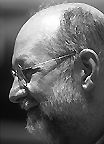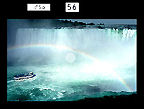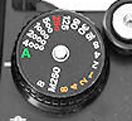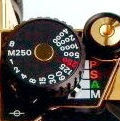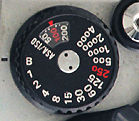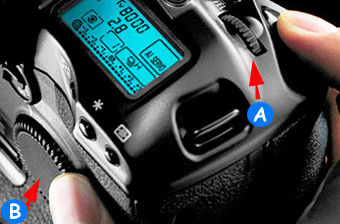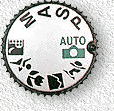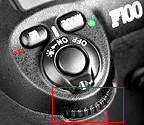 |
What is an "aperture" ? |
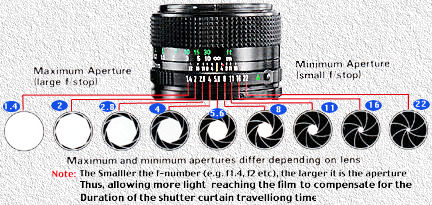 |
Note: the diaphragm blades inside this manual focus Canon FD lens control the amount of light passing through the lens that eventually hitting to the film during an exposure process. The 'amount', or simply explained in layman term - opening changes according to selection of aperture (f/number). In this case, it is indicated by the f-numbers that imprinted on the lens barrel. |
LENS SIDE:- If a simple word "diaphram" can be confusing to you, just try to think numbers engraved on the lens barrel are NOT referred to aperture diaphragm BUT rather, there are just number to let you refer the size of the lens diaphragm. So, if you are new to this, just memorize these numeric settings that will do, as they represent the corresponding size of the lens diaphram inside the lens and let you determine and control how much light you would require to let into the camera for a proper exposure by way of selecting an appropriate aperture diaphragm from large to small (lens opening). But technically, these numbers refer to the relative physical opening of the lens diaphragm. So, don't worry about the confusing part of them.
NOTE:- When you are one level up:- *.. These numbers are very significant to the lenses because they are calculated based on the properties of the lens they're on. f/5.6 on a wide angle lens will not have the same diameter as another, say on a long lens. There are simple lens formulas which help calculate the different properties. But the f number diameter is unique to each lens..". Benoit Aubry (benoit_aubry@hotmail.com but I would rather teach a new budding photographer whio may be interested in picking some pieces rather than serving technical request of a more seasoned photographer. But ant=yway, thanks, pal.
Modern Autofocus
SLR cameras may have a different ways in manipulating the aperture. One of the trend
is - the aperture value is now control via a thumb wheel on the camera (usually near
the shutter release button) and the AF lens has no aperture ring to alter the value.
Each camera manufacturer usually has their own series of lenses under a trade name
to verify its usage, various compatibility issues with their previous camera model's
function etc. For an instance, Canon manual focus lenses are called
"FD" or "FL";
while their newer series of autofocus lenses (AF) designed for their Canon
EOS Series
cameras are referred as "EF" (Electro Focus). Each of these MF/AF
lenses has their own respective way to illustrate the control of aperture in the
camera. When you turn the aperture ring on a lens to vary the aperture, you will
be able to check visually the set opening of the lens diaphragm (Opens bigger or
stopping smaller).
* here in
this section, I am confining the discussion
within the MANUAL FOCUS lenses ONLY
because the proportion of used equipment forms the basis for a cheap, easy entry
for potential new serious photographers.
* Some lenses such
as those made by Canon (See above), the lens diaphragm will not react to turning,
unless you press the aperture pin.
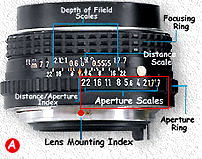 |
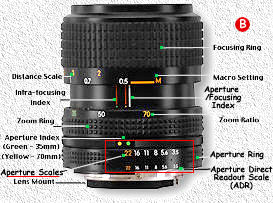 |
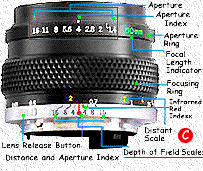 |
Reminder:- the key to an theoretical good EXPOSURE = Aperture + Shutter speed
| Aperture value(s): | f/64, f/32, f/22, f/16, f/11, f/8.0, f/5.6, f/4.0, f/2.8, f/2.0, f/1.8/f1.4 etc. (WE ARE HERE) | Control via the lens section |
| Shutter speed(s): | 1/8000, 1/4000, 1/2000, 1/1000, 1/500, 1/250, 1/125, 1/60, 1/30, 1/15, 1/8, 1/4, 1/2, 1 sec, etc. | Control via the Camera section |
Remember: For a theoretical "perfect" exposure to be formed i.e. nice colour balance, every details shown or simply a photo that you are happy about, take a good combination between using an aperture with the appropriate matching shutter speed for any given film speed (ASA/ISO) are required. The latter refers to the film speed of the film roll used. i.e. ASA 100, ASA 200, ASA 400 etc. the faster the film speed used, you can use to capture lower lighting situation but at the expense of grainer output of prints / slides. Next, a little confusion may create for you to learn here: - each step increment in the use of film speed will also indirectly correspond with one step of aperture OR shutter speed.
I know you must be asking a mind boggling question while you read until here: Ooi....HOW THE HELL WOULD I KNOW WHAT APERTURE TO SET on my lens when I take a picture ? Frankly, you need not have to ! Inside any modern camera, there is a metering cell residing internally which measures the light intensity of the scene you are trying to capture/pointing to. Its metering circuitry will SUGGEST an exposure for you. For an instance, the exposure suggests by the camera's internal metering circuitry indicates 1/125 sec. (camera) with f/8.0 (lens) will deliver a decent exposure for your intended capture. You can override the camera setting (depends on whether the camera has such option for you to manipulate the aperture on the lens OR shutter speed on the camera, most P&S don't offer such options but a SLR camera usually does). For an example, change the f/8.0 to f/4.0 (let in more light by 2 steps 4.0-->5.6-->8.0) and compensate the shutter speed by few stops by limiting light entering the camera shutter i.e. 1/125--->1/250--->1/500. The compensated 2 steps on the shutter speed still delivers the SAME EXPOSURE as the earlier camera suggested reading. The difference is now with a f/4.0, you can achieve a narrow Depth of Field (refer to below WHY and WHAT difference it will bring to your picture with such alternation).. |
However, the MOST confusing part for any new photographer is: Just remember in photographic term: a BIG aperture is actually referring to a smaller number engraved on the aperture ring of the lens i.e. f/1.4, f/2, f/2.8, f/4.0 etc. while small apertures mean bigger numbers i.e. f/22, f/16, f/11, f/8 etc. Once you have "overcome" such "mental block" in calculation, it should help you greatly understand / enjoy reading more in other sections that follow. So, it is important that you OUGHT to digest this paragraph. (CLICK HERE to understand the relation of those numbers found on the lens where how the lens diaphragm inside at each aperture set. Well, I am not sure who was the hell was the bloody smart guy who first started by inverting the number on the aperture on the lens - where small number (f/2.0, f/2.8 etc.) is actually referring to a larger lens opening while big number(s) such as f/11, f/16, f/22 etc. is actually smaller aperture. Basically, large aperture (f/2.0, f/2.8 etc.) lets in more light to the camera shutter for an exposure, while small aperture (f/11, f/16, f/22 etc.) has a smaller opening in the lens diaphragm to let in LESS light for a given exposure. The confusion usually causes a beginner who might be poor in mathematics gives up serious photography from here @#$^*#&*!!. Well, I guess you are not within that figures-fophia group, so - why don't just be patience and spends a few minutes to DIGEST this part. Trust me, it worth the time and could reward you with plenty of joy with the camera you own. |
About aperture and its direct relation that might affect in your photography:- i.e. Other than controlling the amount of light entering into the camera, What else does "apertures" do ?
When the shutter button is released, light passes through the aperture diaphragm and hit the film, an exposure is formed. Basically, aperture, along with duration/timing of the shutter curtain opening, BOTH contribute to a the formation of an exposure. But aperture also affects an important photographic element called "depth of field" (short form "DOF"). You may ask, what is hell is this "Depth of Field" ? Depth of field is just technical term used to describe the 'zone' of sharpness' between nearest and furthest of a subject in focus (to be more exact, distance of sharp focus in front and behind, subject on which the lens is focused).
There
are a few elements that will affects Depth of Field in a picture
(Note:- Factors on lens ONLY,
shutter speed never affects depth of field):

